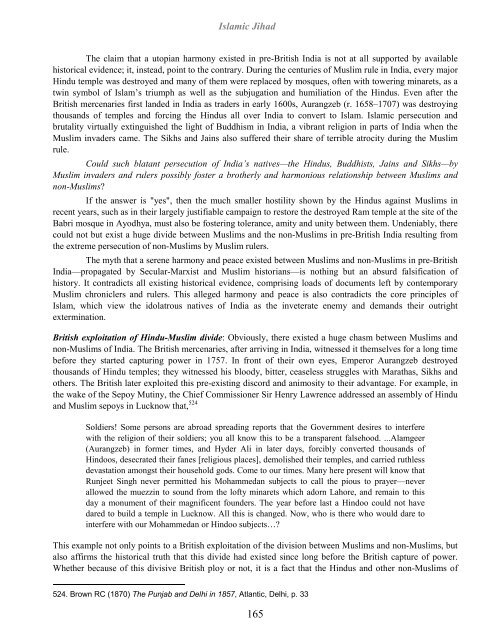islamic-jihad-legacy-of-forced-conversion-imperialism-slavery
islamic-jihad-legacy-of-forced-conversion-imperialism-slavery
islamic-jihad-legacy-of-forced-conversion-imperialism-slavery
- No tags were found...
You also want an ePaper? Increase the reach of your titles
YUMPU automatically turns print PDFs into web optimized ePapers that Google loves.
Islamic JihadThe claim that a utopian harmony existed in pre-British India is not at all supported by availablehistorical evidence; it, instead, point to the contrary. During the centuries <strong>of</strong> Muslim rule in India, every majorHindu temple was destroyed and many <strong>of</strong> them were replaced by mosques, <strong>of</strong>ten with towering minarets, as atwin symbol <strong>of</strong> Islam’s triumph as well as the subjugation and humiliation <strong>of</strong> the Hindus. Even after theBritish mercenaries first landed in India as traders in early 1600s, Aurangzeb (r. 1658–1707) was destroyingthousands <strong>of</strong> temples and forcing the Hindus all over India to convert to Islam. Islamic persecution andbrutality virtually extinguished the light <strong>of</strong> Buddhism in India, a vibrant religion in parts <strong>of</strong> India when theMuslim invaders came. The Sikhs and Jains also suffered their share <strong>of</strong> terrible atrocity during the Muslimrule.Could such blatant persecution <strong>of</strong> India’s natives—the Hindus, Buddhists, Jains and Sikhs—byMuslim invaders and rulers possibly foster a brotherly and harmonious relationship between Muslims andnon-Muslims?If the answer is "yes", then the much smaller hostility shown by the Hindus against Muslims inrecent years, such as in their largely justifiable campaign to restore the destroyed Ram temple at the site <strong>of</strong> theBabri mosque in Ayodhya, must also be fostering tolerance, amity and unity between them. Undeniably, therecould not but exist a huge divide between Muslims and the non-Muslims in pre-British India resulting fromthe extreme persecution <strong>of</strong> non-Muslims by Muslim rulers.The myth that a serene harmony and peace existed between Muslims and non-Muslims in pre-BritishIndia—propagated by Secular-Marxist and Muslim historians—is nothing but an absurd falsification <strong>of</strong>history. It contradicts all existing historical evidence, comprising loads <strong>of</strong> documents left by contemporaryMuslim chroniclers and rulers. This alleged harmony and peace is also contradicts the core principles <strong>of</strong>Islam, which view the idolatrous natives <strong>of</strong> India as the inveterate enemy and demands their outrightextermination.British exploitation <strong>of</strong> Hindu-Muslim divide: Obviously, there existed a huge chasm between Muslims andnon-Muslims <strong>of</strong> India. The British mercenaries, after arriving in India, witnessed it themselves for a long timebefore they started capturing power in 1757. In front <strong>of</strong> their own eyes, Emperor Aurangzeb destroyedthousands <strong>of</strong> Hindu temples; they witnessed his bloody, bitter, ceaseless struggles with Marathas, Sikhs andothers. The British later exploited this pre-existing discord and animosity to their advantage. For example, inthe wake <strong>of</strong> the Sepoy Mutiny, the Chief Commissioner Sir Henry Lawrence addressed an assembly <strong>of</strong> Hinduand Muslim sepoys in Lucknow that, 524Soldiers! Some persons are abroad spreading reports that the Government desires to interferewith the religion <strong>of</strong> their soldiers; you all know this to be a transparent falsehood. ...Alamgeer(Aurangzeb) in former times, and Hyder Ali in later days, forcibly converted thousands <strong>of</strong>Hindoos, desecrated their fanes [religious places], demolished their temples, and carried ruthlessdevastation amongst their household gods. Come to our times. Many here present will know thatRunjeet Singh never permitted his Mohammedan subjects to call the pious to prayer—neverallowed the muezzin to sound from the l<strong>of</strong>ty minarets which adorn Lahore, and remain to thisday a monument <strong>of</strong> their magnificent founders. The year before last a Hindoo could not havedared to build a temple in Lucknow. All this is changed. Now, who is there who would dare tointerfere with our Mohammedan or Hindoo subjects…?This example not only points to a British exploitation <strong>of</strong> the division between Muslims and non-Muslims, butalso affirms the historical truth that this divide had existed since long before the British capture <strong>of</strong> power.Whether because <strong>of</strong> this divisive British ploy or not, it is a fact that the Hindus and other non-Muslims <strong>of</strong>524. Brown RC (1870) The Punjab and Delhi in 1857, Atlantic, Delhi, p. 33165


